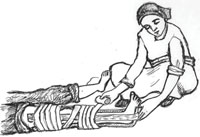Supportive care for a bone fracture
IV fluids to replace lost blood
You have learnt that it is very important to give IV fluid to someone who has shock and low blood volume due to blood loss from an injury or other causes. The amount of blood lost in fractures depends on the type of bone affected and the severity of the fracture. The larger the size of bone fractured, you should expect more blood to be lost. The amount of internal bleeding following a fracture is estimated as:
- About 1.5 l (litres) of blood is lost following fracture of a single thigh bone
- About 1.0 l is lost following fracture of bones of the lower leg (calf).
You should also be aware that fracture of a relatively small bone may result in a much larger amount of bleeding if there is associated injury to a major blood vessel. Therefore, you should always check for signs of shock after a fracture and begin IV fluid infusion if the person's blood pressure falls and the pulse rises. Also give the person two paracetamol tablets with a small cup of water to relieve the pain of the fracture.
Immobilising a fractured limb
The other important component of basic supportive care for a person with a fracture in a large bone (e.g. in the arm or leg) is to immobilise the injured limb before transporting the person to a health centre or hospital.
Why do you think immobilising the limb is important?
It prevents further damage to the limb, which can happen if it moves and the sharp ends of the fractured bone push out through the skin.
A fractured limb is immobilised by keeping it straight, using a rigid material called a splint, which you can make from anything like very strong cardboard, a plank of wood, or similar material. The splint should be as long as the whole arm or leg (not just the broken part) to stop movement in the joint above and below the fractured site. It is usually fixed behind the affected limb by wrapping soft cloths around the limb and the splint to bind them together (see Figure 7.5). This process is called splinting. Splinting prevents further damage, which may result in loss of the limb or disability at a later period.

Once you have applied the splint and fixed it securely, the next step is to make sure that the person reaches a hospital or health centre in a splinted state in order not to aggravate the injury further. By doing this you ensure that the patient is treated in a more specialised and complete way, which helps reduce the risk of death or disability from fracture.